The family Caprimulgidae contains the Nightjars. Their closest relatives are Owlet Nightjars of family Aegothelidae and Frogmouths of Family Podargidae. They are found around the world, hunt in low light, and feed on large flying insects.
See also Old World Nightjars.
Genus Antrostomus also Caprimulgus
With all cryptically-colored night birds, identification is best accomplished by hearing the bird’s voice.
Chuck-will's-widow Antrostomus carolinensisFound: The Americas
Chuck-will's-widow has mottled brownish underparts, buff throat, reddish-brown feathers lined with black and brown and white patterning on head and chest.
Similar to: Eastern Whip-poor-will. Difficult to distinguish between Chuck-will's Widow and Eastern Whip-poor-will. Chuck-will's-widow has a similar but lower-pitched and slower call.
Image by: 1, 2, 3, 4, 5, 6, 7) Dick Daniels - North Carolina 8) Louis Agassiz FuertesSimilar to: Eastern Whip-poor-will. Difficult to distinguish between Chuck-will's Widow and Eastern Whip-poor-will. Chuck-will's-widow has a similar but lower-pitched and slower call.
1) The eggs clearly identify that this bird is a Chuck-will's-widow, not an Eastern Whip-poor-wiil. The following photos are of the mother. 2, 3, 4) Female camouflaged on nest 5) Female pretending to be hurt 6. 7) Female 8) Male upper, female lower


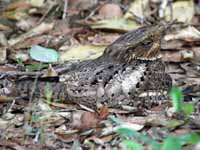





Nightjar,_Buff-collared Antrostomus ridgwayi Found: Mexico, Central America
The Buff-collared Nightjar has dark upperparts and breast with with brown, gray, black, and white patterning;dark brown tail with fine barring. Males have white tips to outer tail feathers; females have buffish tips.
Image by: 1) Francesco Veronesi - Mexico 2) Tyler Pockette

Nightjar,_Dusky Antrostomus saturatus Found: Costa Rica, Panama
The Dusky Nightjar has brownish upperparts; buff throat-band; lack of white wing markings. Males have white tips to outer tail feathers; females have buffish tips.
Image by: 1) John Gerrard Keulemans 2) Tom Benson 3) Nick Athanas - Costa Rica
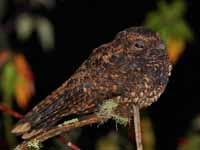

Nightjar,_Greater Antillean Antrostomus cubanensis Found: Cuba, Dominican Republic, Haiti
The Greater Antillean Nightjar has brownish-black upperparts and wing-coverts speckled greyish-white, greyish-brown, and buff; crown streaked with black; no hind-neck collar; dark brown underparts speckled and spotted buffish-white. The three outermost pairs of rectrices of the male are broadly tipped with white; the tips of the rectrices of the female are buffy.
Image by: 1) Pinebird 2) Miguel Landostoy

Nightjar,_Puerto Rican also Puerto Rican Whip-poor-will Antrostomus noctitherus Found: Puerto Rico
The Puerto Rican Nightjar hase mottled gray, brown, and black plumage. Male has black throat bordered by white band; white in outer-tail feathers. Female has buff colored throat band; buff outer-tail feathers.
Image by: 1, 2, 3, 4) Mike Morel - USFWS 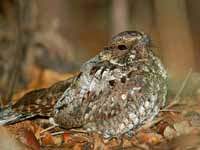


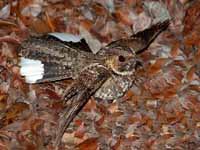
Nightjar,_Rufous Antrostomus rufus Found: Central and South America
The Rufous Nightjar has rusty-brown plumage; dark speckling on mantel; buff rear-neck collar; whitish fore-neck. Male has white in the tail; females have brownish tails
Image by: 1) Joseph Smit 2) Dave Roach 3) Richard Collier1) Male



Nightjar,_Silky-tailed Antrostomus sericocaudatus Found: Argentina, Bolivia, Brazil, Paraguay, Peru
Image by: 1) Brenda Gayle Bush

Nightjar,_Tawny-collared Antrostomus salvini Found: Mexico, Nicaragua
The Tawny-collared Nightjar has generally grayish plumage; narrow rufous collar along nape; mainly dark primaries.
Image by: 1) John Gerrard Keulemans
Nightjar,_Yucatan Antrostomus badius Found: Central America
The Yucatan Nightjar has a cinnamon hind-collar; white fore-collar.Its viuce is a loud, clear puc ree-u-reeeu’ or pc weeu wee-weeu.
Image by:
1) Marcel Hoyoak - Mexico 2) Naturetrek Wildlife Holiday

Whip-poor-will, Eastern Antrostomus vociferus Found: Central America, North America
The Eastern Whip-poor-will has a mottled plumage: the upperparts are grey, black and brown; the lower parts are grey and black; very short bill; black throat. Males have a white patch below the throat and white tips on the outer tail feathers; in the female, these parts are light brown.
Similar to: Chuck-will's Widow. Difficult to distinguish between Chuck-will's Widow and Eastern Whip-poor-will. Chuck-will's-widow has a similar but lower-pitched and slower call.
Similer to: Mexican Whip-poor-will. Range of Eastern Whip-poor-will and Mexican Whip-poor-will don't usually overlap. Vocalizations and egg colorartion are different.
Image by: 1) Louis Fuertes 2) Laura Gooch - Ohio 3, 4, 5, 6) Jerry Oldenettel - New Mexico
Similar to: Chuck-will's Widow. Difficult to distinguish between Chuck-will's Widow and Eastern Whip-poor-will. Chuck-will's-widow has a similar but lower-pitched and slower call.
Similer to: Mexican Whip-poor-will. Range of Eastern Whip-poor-will and Mexican Whip-poor-will don't usually overlap. Vocalizations and egg colorartion are different.




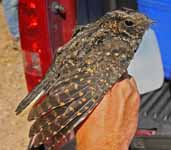

Whip-poor-will, Mexican Antrostomus arizonae Found: southwest United States, Mexico
The Mexican Whip-poor-will has a mottled plumage: the upperparts are grey, black and brown; the lower parts are grey and black; very short bill; black throat. Males have a white patch below the throat and white tips on the outer tail feathers; in the female, these parts are light brown
Similer to: Eastern Whip-poor-will. Range of Eastern Whip-poor-will and Mexican Whip-poor-will don't usually overlap. Vocalizations and egg colorartion are different. .
Image by: 1) Dave Krueper - Mexico 2) Tripp Davenport - ArizonaSimiler to: Eastern Whip-poor-will. Range of Eastern Whip-poor-will and Mexican Whip-poor-will don't usually overlap. Vocalizations and egg colorartion are different. .
1) Chick


Genus Chordeiles
Nighthawk, Antillean Chordeiles gundlachii Found: North America (Florida), Caribbean
Similar to: Common Nighthawk. Antillean Nighthawk and Common Nighthawk are very similar. Voice or range is the best identifier. If the nighthawk is in the USA and not in Florida, then it is probably not Antillean Nighthawk.
Similar to: Lesser Nighthawk. As seen when in flight, white wing-bar of Lesser Nighthawk is closer to wing tip than for other Antillean Nighthawk. Range does not overlap in USA.
Image by: 1) Dan Irizarry - Florida 2) Marcel Holyoak - Florida 3) Jerry Oldenettel - FloridaSimilar to: Lesser Nighthawk. As seen when in flight, white wing-bar of Lesser Nighthawk is closer to wing tip than for other Antillean Nighthawk. Range does not overlap in USA.



Nighthawk, Common Chordeiles minor Found: The Americas
Similar to: Antillean Nighthawk. Antillean Nighthawk and Common Nighthawk are very similar. Voice or range is the best identifier. If the nighthawk is in the USA and not in Florida, then it is probably not Antillean Nighthawk.
Similar to: Lesser Nighthawk. As seen when in flight, white wing-bar of Lesser Nighthawk is closer to wing tip than for other Common Nighthawk.
Image by: 1) Jerry Oldenettel 2) Gavin Keefe Schaefer - British Columbia 3)
Charlie Westerinen - Baker City, OregonSimilar to: Lesser Nighthawk. As seen when in flight, white wing-bar of Lesser Nighthawk is closer to wing tip than for other Common Nighthawk.
1) Rufous adult 2) Dark adult 2)


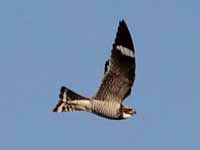
Nighthawk, Least Chordeiles pusillus Found: South America
The Least Nighthawk has brown upperparts with gray, rufous, and buff spots; whitish or buff underpartsbarred with brown.
Image by: 1, 2) Mauricio Mercadante - Brazil

Nighthawk,_Lesser Chordeiles acutipennis Found: Southwest USA to South America
Similar to: Antillean Nighthawk, Common Nighthawk. As seen when in flight, white wing-bar of Lesser Nighthawk is closer to wing tip than for other nighthawks.
Similar to: Common Pauraque, Ladder-tailed Nightjar. Commorn Pauraque has wide line through eye; Ladder-tailed Nightjar, Lesser Nighthawk do not.
Image by: 1) Nick Athanas - Ecuador 2) Charlie Westerinen - Truckee, California 3) Pat Gaines - New Mexico 4) Dominic Sherony - Florida 5) Jerry Oldenettel - Costa Rica 6) barloventomagico - VenezuelaSimilar to: Common Pauraque, Ladder-tailed Nightjar. Commorn Pauraque has wide line through eye; Ladder-tailed Nightjar, Lesser Nighthawk do not.






Nighthawk,_Nacunda Chordeiles nacunda Found: South America
The Nacunda Nighthawk has light brown upperparts with dark speckles; white throat, belly; black primary flight feathers bordered by white band.
Image by: 1) Rick Ellis Simpson 2) Allan Hopkins - Guyana 3) Nick Athanas - Brazil 4) Claudio Timm



Nighthawk,_Sand-colored Chordeiles rupestris Found: South America
Image by: 1) Nick Athanas 2) Vince Smith - Ecuador 3) Gunther Eichhorn - Ecuador 4) Claudio Timm - Brazil




Genus Eleothreptus also Caprimulgus
Nightjar,_Sickle-winged Eleothreptus anomalus also Caprimulgus anomalus Found: Argentina, Brazil, Paraguay, Uruguay
The Sickle-winged Nightjar has mainly gray-brown plumage; distinctive black scapular spotting; unique wing shape.
Image by:
1) Joan and George - southeast Brazil 2) Brooks Crockett

Nightjar,_White-winged Eleothreptus candicans also Caprimulgus candicans Found: Bolivia, Brazil, Paraguay
The male White-winged Nightjar has extensive white on wings and tail that is plainly visible during courting displays. Female lacks these white markings and is superficially similar to Sickle-winged Nighthjar.
Image by: 1) Marcelo Prest 2) Jean-Paul Brouard1) Male


Genus Hydropsalis
Nightjar,_Ladder-tailed Hydropsalis climacocerca Found: South America
Similar to: Common Pauraque, Lesser Nighthawk. Commorn Pauraque has wide line through eye; Ladder-tailed Nightjar, Lesser Nighthawk do not.
Image by: 1) Nick Athanas - Brazil 2, 3) Cláudio Timm - the Amazon, Brazil1, 2) Female 3) Male



Nightjar,_Scissor-tailed Hydropsalis torquata Found: South America
The male Scissor-tailed Nightjar has scissor-like elongated tail feathers. Female has slightly elongated tail feathers.
Image by: 1, 3, 4) Claudio Timm 2) Carlos_Henrique - Brazil1) Female 2, 3, 4) Male




Nightjar,_Spot-tailed Hydropsalis maculicaudus also Caprimulgus maculicaudus Found: Central and South America
The Spot-tailed Nightjar has generally buff plumage; relatively short tail; narrow rufous collar across nape.
Image by:
1) Joseph Smit 2) Vincent Vos 3) Nick Athanas - Brazil


Nightjar,_White-tailed Hydropsalis cayennensi also Caprimulgus cayennensi Found: South America
The White-tailed Nightjar has light orange-buff collar on nape; long notched tail. Male has mostly white tail; female lacks the white tail markings..
Image by: 1) Kate Nevins 2) Dominic Sherony - Tobago 3) Dave Curtis - Surama


Genus Lurocalis
Nighthawk, Rufous-bellied Lurocalis rufiventris Found: South America
The Rufous-bellied Nighthawk has long-wings; short tail; white throat; tawny belly; all-dark wings, tail.
Similar to: Short-tailed Nighthawk. The Rufous-bellied Nighthawk occurs at higher elevations than Short-tailed Nighthawk, It is larger and the belly lacks the black barring of Short-tailed.
Image by: 1, 2) Scott Olmstead - Ecuador Similar to: Short-tailed Nighthawk. The Rufous-bellied Nighthawk occurs at higher elevations than Short-tailed Nighthawk, It is larger and the belly lacks the black barring of Short-tailed.


Nighthawk, Short-tailed Lurocalis semitorquatus Found: Central and South America
The Short-tailed Nighthawk has generally blackish upperparts with cinnamon-rufous spotting; no collar; white patch on throat; blackish-brown breast with paler spots; black barring on belly.
Similar to: Rufous-bellied Nighthawk. The Rufous-bellied Nighthawk occurs at higher elevations than Short-tailed Nighthawk, It is larger and the belly lacks the black barring of Short-tailed.
Image by: 1) Larry Kay 2) Douglas BeteSimilar to: Rufous-bellied Nighthawk. The Rufous-bellied Nighthawk occurs at higher elevations than Short-tailed Nighthawk, It is larger and the belly lacks the black barring of Short-tailed.


Genus Macropsalis - 1 species
Nightjar,_Long-trained Macropsalis forcipata Found: northeast Argentina and southeast Brazil
Image by: 1, 2) Hector Bottai 3) Sidnei Dantas



Genus Nyctidromus - 1 species
Pauraque,_Common also Pauraque Nyctidromus albicollis Found: southwest North America, South America
Similar to: Ladder-tailed Nightjar, Lesser Nighthawk. Commorn Pauraque has wide line through eye; Ladder-tailed Nightjar, Lesser Nighthawk do not.
Image by: 1) Felineora 2) Bernard - Belize 3) Marek Stefunko


Genus Nyctiphrynus
Poorwill, Ocellated Nyctiphrynus ocellatus Found: Central and South AmericaImage by: 1) Hector Bottai - Brazil 2) brenda gayle bush - Peru


Poorwill, Yucatan Nyctiphrynus yucatanicus Found: Yucatán Peninsula in Mexico, Guatemala, Belize
Image by: 1) John Gerrard Keulemans

Genus Nyctipolus or Caprimulgus
Nightjar,_Blackish Nyctipolus nigrescens also Caprimulgus nigrescens Found: Guianas and the Amazon of South America
Image by:1) Nick Athanas - Brazil 2) Hector Bottai - Brazil 3) Allan Hopkins - Guyana 4) Sean McCann - French Guiana




Nightjar,_Pygmy Nyctipolus hirundinaceus also Nyctipolus hirundinaceus Found: Brazil
Image by: 1, 2) Rick Ellis Simpson


Genus Nyctiprogne
Nighthawk, Bahian also Plain-tailed Nighthawk Nyctiprogne vielliardi Found: Brazil in valley of Rio Sao Francisco
Similar to: Band-tailed Nighthawk. Band-tailed Nighthawk has white band on under-tail; Plain-tailed Nighthawk does not.
Image by: 1) Ciro Albano
Nighthawk, Band-tailed Nyctiprogne leucopyga Found: South America
The Band-tailed Nighthawk has dark upperparts; darkly barred underparts; white bar on under-tail near its base. It flies in an erratic bat-like flight pattern.
Similar to: Bahian Nighthawk. Band-tailed Nighthawk has white band on under-tail; Plain-tailed Nighthawk does not.
Image by: 1) Allan Hopkins - Guyana 2) Vivek Tiwari - Brazil 3) Alexander PoellingerSimilar to: Bahian Nighthawk. Band-tailed Nighthawk has white band on under-tail; Plain-tailed Nighthawk does not.
1) Juveniles



Genus Phalaenoptilus - 1 species
Poorwill, Common Phalaenoptilus nuttallii Found: British Columbia, western United States, northern Mexico
Image by: 1) Louis Agassiz Fuertes 2) Aaron Maizlish - California 3) Ken-ichi Ueda - California
1) Foreground - Phalaenoptilus nuttallii nuttallii; Background - P. n. californicus 2) P. n. n. 3) P. n. c



Genus Setopagis also Caprimulgus
Nightjar,_Little Setopagis parvulus also Caprimulgus parvulus Found: South America
The Little Nightjar has grayish-brown plumage; broad tawny-colored hindneck collar, white throat patch, white patch close to the wingtip,
Image by: 1) Carlos_Henrique - Brazil 2) Claudio Timm 3) Gustavo Duran 


Nightjar,_Roraiman Setopagis whitelyi also Caprimulgus whitelyi Found: Brazil, Venezuela, Guyana
Thre Roraiman Nightjar has very dark plumage; lacks rufous collar across nape.
Image by: 1) John Gerrard Kuelemans
Nightjar,_Todd's Setopagis heterurus also Caprimulgus heterurus Found: Colombia, Venezuela, Guyana
Image by: 1) Justin Hite

Genus Siphonorhis
Pauraque, Jamaican also Jamaican Poorwill Siphonorhis americana Found: Jamaica
The Jamaican Pauraque has brown plumage with cryptic plumage with black, white, and buffy patterning; large white throat collar.
Image by: 1) George Edward Lodge
Pauraque, Least also Least Poorwill Siphonorhis brewsteri Found: Dominican Republic, Haiti
Image by: 1) Rafael Arvelo 2) Miguel A. Landestoy


Genus Systellura - 1 species
Nightjar,_Band-winged Systellura longirostris also Caprimulgus longirostris Found: South America
The Band-winged Nightjar has mottled gray and brown plumage; long, square tale; rufous hind collar; white fore collar.
Image by: 1) Pablo Necochea - Chile 2) Rick Elis Simpson 3) Nick Athanas - Ecuador


Genus Uropsalis
Nightjar,_Lyre-tailed Uropsalis lyra Found: South America
Image by: 1) Claudio Timm - Peru 2) Jerry Oldenettel - Ecuador 3, 4) Nick Athanas - Ecuador


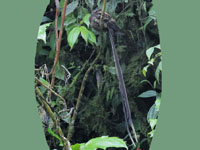

Oilbird Steatornis caripensis Found: Panama, northern South America
The Oilbird is nocturnal and uses ecolocation to navigate. It has mainly reddish-brown upperparts; white spots on nape, wings; cinnamon-buff underparts spotted white. The nightjars are probably the oilbird's nearest relatives.
Image by: 1) Barloventomagico 2) Alastair_Rae 3) Nick Athanas - Ecuador

